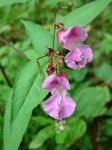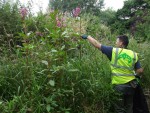Himalayan Balsam
Way back in 1839, a selection of foreign plants were introduced to Britain as a way of allowing poor working-class folk to have a cheap, beautiful flower garden. For this purpose, the idea was to introduce plants that spread very rapidly, so much so that even the purchase of a single flower would fill the garden within a year or two.
The best laid plans o’ mice an’ men gang aft agley … the problem with plants that spread very rapidly when you do want them to do so, is that they continue to spread very rapidly even when you don’t. They then become an increasingly large nuisance, and eventually are classed as invasive non-native species. Of these nuisances, one that looms very large along the banks of the river Cale – figuratively and literally, since it reaches up to six feet high! – is Himalayan Balsam.

Unfortunately, despite being pleasant to look at, Himalayan Balsam wreaks havoc upon river wildlife.
The common name, along with another nickname of Kiss-me-on-the-mountain, refer to its origins in the Himalayas. It is in fact a very pretty flower and it is easy to see why it was introduced to gardens; some gardeners still cultivate it for that reason. And, as long as they do not allow it to spread into the wild, they are breaking no laws.
In the wild, things are very different. Because it grows so tall, so fast, Himalayan Balsam will overshade almost all native plants, depriving them of sunlight and preventing them from growing at all. This, couple with its ability to spread at great speed, leads to it taking over whole stretches of riverbank, which is a particular problem because of another of its traits – very shallow roots. In winter, when the plant dies back, it leaves nothing behind to hold together the soil, and if that soil is part of a riverbank the river flow will then wash it away, eventually eroding the riverbanks down to bare rock. For wildlife such as kingfishers and water voles that make their home in the soil of the riverbank, this is clearly bad news.
Consequently, one of the major activities for CATCH in the summer months is trying to remove the plant before it has a chance to set its seeds. Himalayan Balsam belongs to a group of plants, given the Latin name impatiens, which spread their seeds by exploding. The seed pod from a single flower, when it is disturbed, will disintegrate and scatter seeds in all directions, to a distance of up to eight yards. Those seeds can then grow to form a full, six-foot-high plant the very next season. Fortunately, and very unlike Japanese Knotweed, it is easy to remove. The shallow roots which are the chief reason it is such a problem, also mean that it can simply be pulled bodily out of the ground and left to die. Provided this is done before the seed pods have formed, it will then be unable to spread.
It is a long ongoing battle, because even if we remove 99.9% of the plants in one summer, the tiny remaining fraction will come back strong and take over again if we don’t keep going. It is likely that for several years yet, you will see CATCH adverts asking for volunteers to come and pull up flowers along the riverbank. But the long-term outlook is positive: it may be a long, slow battle, but we think we are winning!



